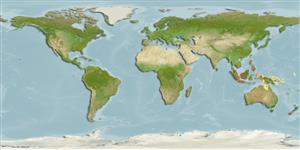Environment: milieu / climate zone / depth range / distribution range
Ecología
marino; salobre demersal. Tropical
Western Central Pacific: southern Viet Nam to Java and western Borneo.
Tamaño / Peso / Age
Maturity: Lm ? range ? - ? cm
Max length : 30.0 cm SL macho / no sexado; (Ref. 9772); common length : 20.0 cm SL macho / no sexado; (Ref. 9772)
Short description
Morfología | Morfometría
Espinas dorsales (total): 10 - 11; Radios blandos dorsales (total): 33-36; Espinas anales 2; Radios blandos anales: 6 - 7; Vértebra: 11 - 25. One or two spines on supraorbital ridge of frontal in juveniles (up to 50 mm SL); transition from cycloid to ctenoid scales initiated at around 30 mm SL; all body scales, except on throat, ctenoid over 60 mm SL; scales absent on soft parts of dorsal and anal fins; lateral line scales covered with small, subsidiary scales; cephalic portion of swimbladder appendage terminating on caudal foramen of cranium (Ref 10086).
Inhabits shallow coastal waters and estuaries; young and juveniles occur in mangrove swamps (Ref. 9772). Also caught with bottom trawls, and handlines (Ref. 9772). Sold fresh and dried salted in markets.
Life cycle and mating behavior
Madurez | Reproducción | Puesta | Huevos | Fecundidad | Larva
Sasaki, K., 1995. A review of the Indo-West Pacific sciaenid genus Panna (Teleostei, Perciformes). Jap. J. Ichthyol. 42(1):27-37. (Ref. 10086)
IUCN Red List Status (Ref. 130435)
Threat to humans
Harmless
Human uses
Pesquerías: escaso valor comercial
Más información
Nombres comunesSinónimosMetabolismoDespredadoresEcotoxicologíaReproducciónMadurezPuestaAgregación para la puestaFecundidadHuevosEgg development
Age/SizeCrecimientoLength-weightLength-lengthLength-frequenciesMorfometríaMorfologíaLarvaDinámica larvariaReclutamientoAbundanciaBRUVS
ReferenciasAcuiculturaPerfil de acuiculturaRazasGenéticaElectrophoresesheritabilidadEnfermedadesProcesamientoNutrientsMass conversion
ColaboradoresImágenesStamps, Coins Misc.SonidosCiguateraVelocidadTipo de nataciónSuperficie branquialOtolitosCerebrosVisión
Herramientas
Special reports
Download XML
Fuentes de Internet
Estimates based on models
Preferred temperature (Ref.
123201): 27.1 - 29.2, mean 28.5 °C (based on 988 cells).
Phylogenetic diversity index (Ref.
82804): PD
50 = 0.6250 [Uniqueness, from 0.5 = low to 2.0 = high].
Bayesian length-weight: a=0.00575 (0.00278 - 0.01190), b=3.11 (2.93 - 3.29), in cm total length, based on LWR estimates for this (Sub)family-body shape (Ref.
93245).
Nivel trófico (Ref.
69278): 3.6 ±0.4 se; based on size and trophs of closest relatives
Resiliencia (Ref.
120179): Alto, población duplicada en un tiempo mínimo inferior a 15 meses (Preliminary K or Fecundity.).
Fishing Vulnerability (Ref.
59153): Low to moderate vulnerability (27 of 100).
Nutrients (Ref.
124155): Calcium = 182 [99, 348] mg/100g; Iron = 1.03 [0.55, 1.80] mg/100g; Protein = 18.6 [17.4, 19.7] %; Omega3 = 0.168 [0.081, 0.313] g/100g; Selenium = 57.8 [29.8, 119.2] μg/100g; VitaminA = 21.7 [8.3, 62.8] μg/100g; Zinc = 1.4 [1.0, 2.0] mg/100g (wet weight);
